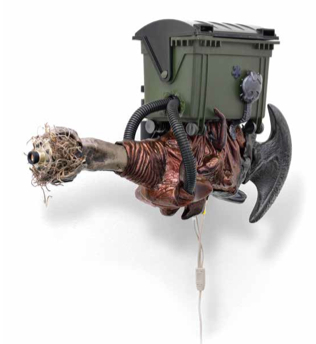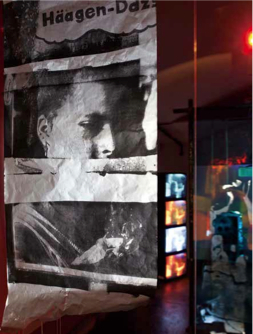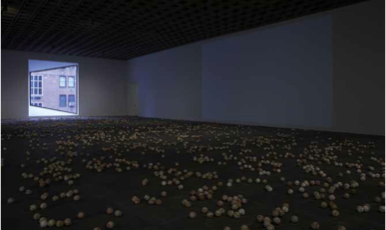MOVING UP
| 2013年06月04日 | 发表于 LEAP 20
NICOLAS CECCALDI
A friend recently complained about Nicolas Ceccaldi’s exhibition “Wearables” at Real Fine Arts in Brooklyn: “Yeah, you can tell he’s from Berlin. No one who lives in New York would waste that opportunity.” Though Ceccaldi’s exhibition undoubtedly wasn’t a missed opportunity in the opinion of yours truly, it precisely challenged the male-ego-driven sculpture increasingly common to Western art today. The Canadian-born, former Berlin resident presented a series of creepily feminine, pop-goth glittery painted fairy wings on the Greenpoint gallery’s wooden floor. The exhibition’s press release is something to be admired, and starts, “Condemned and sunburnt under corroded skies, I found refuge at the bottom of a septic tank infested with snails. Spreading my carcass at ease, I drowse in deep oblivion, dreaming of an immense raven to tear me away from this vast sauna far above the high-rise towers…”
Ceccaldi’s larger body of work includes less glittery but equally fantastical post-human-inspired sculpture. A recent series modifies cameras by festooning them with sinister-looking toy parts or sci-fi effects such as a plasma ball. Muffin (2011) replaces the nose of a crawling Winnie-the-Pooh toy with a nanny cam. In Ceccaldi’s world, the morbid aesthetics of emo, science fiction, black metal, and post-humanism— oftentimes commodified for sub-mainstream countercultures with uncanny effect— are all equal parts fodder.
A graduate of Staatliche Hochschule für Bildende Künste, Städelschule in Frankfurt, Ceccaldi is represented by Johan Berggren, Malmö and Neue Alte Brücke, Frankfurt. In addition to solo exhibitions at his representative galleries and Real Fine Arts, he recently launched the two-person exhibition “Garbage World” with Morag Keil at Mark & Kyoko, Berlin; “Films & Windows” with Loretta Fahrenholz at Mathew Gallery, Berlin; as well as “Madina Warfare” with Dan Rees at Sandy Brown in Berlin. Ceccaldi was included in the 2011 survey “Based in Berlin” and group shows including “Interiority Complex” at Cubitt Gallery, London; “Venus in a Shell,” at Fluxia, Milan; and “Join the Black Mamba” at Karma International, Zurich.
NICOLAS DESHAYES
“It’s a lot closer to the body than you think,” artist Nicolas Deshayes said to me in a recent studio visit. He was referring to Soho Fats (2012), a set of five oversized polystyrene panels mounted on aluminum rails recalling common support poles found on buses and subways. While these wire-cut compositions appear closer to underwater terrain than any bodily allusion, the material— polystyrene— is a synthetic polymer derived from petroleum, which, the artist reminded me, is made from the remains of dead organisms (including humans) buried deep underneath sedimentary rock. Deshaye’s work continually refers to the human body in his sculptural installations.
His works combine wall-mounted, extremely durable elements such as anodized aluminum or polyurethane “public amenity board” (commonly found in urinals) that point to an interest in public spaces constructed to endure and facilitate the wear and tear of constant human traffic. For example, Deshayes will place framed, vacuum-formed compositions of what appears to be rippling, wart-infested skin over a set of painterly custom-anodized aluminum sheets. Deshayes introduces the baseness of the human body to the otherwise sterile interior architecture endemic to public space.
Born in Nancy, France and raised in Dublin, Ireland, Deshayes lives and works in London. He recently mounted solo exhibitions at Jonathan Viner and Galleries Goldstein, London; Wysing Arts Centre, Cambridge, as well as a two-person show with George Henry Longly at Galerie Chez Valentin, Paris. Recent group shows include “Original/Copy 2” at Peles Empire, London; “Rain” at Cell Project Space, London; “Glaze” at Bischoff/Weiss, London; and “Changing States of Matter,” Brand New Gallery, Milan. He is represented by Jonathan Viner, London.
HANNAH PERRY
We could consider Hannah Perry a collector or archivist as much as an artist: she stockpiles footage from video libraries, her own family’s home recordings, and sound bites from R&B and hip-hop tracks, and frequently records life’s uncanny moments on her cellphone, all of which find their way into the artist’s sound and moving image collages. While her footage and sound clips vary greatly by source— ranging from bizarre vintage documentaries found deep within the Goldsmiths video library to clips of her 10-year-old niece talking about her oncoming adolescence— Perry processes these in non-hierarchical fashion to become fluid, non-narrative pieces.
While still working on her three-year Master of Fine Arts degree at the Royal Academy in London (she is now in her second year), Perry was the first artist without gallery representation to receive a solo exhibition at the British capital’s Zabludowicz Collection. Titled “Wonderful While it Lasts,” Perry’s March 2012 exhibition for the Zabludowicz Collection was her first foray in melding video elements into physical space, extending her collage from the screen to photographic and sculptural mediums. Similarly, her March 2013 installation at the Royal Academy’s “Premiums” exhibition, which marks the halfway point for the institution’s MFA students, featured Perry continuing to work outside of the screen. Steel scaffolding holds a video monitor flanked by two vibrating subwoofers calibrated to move but emit no sound. Corresponding to the sound of a turbocharged engine’s blow-off valve in her video, Perry’s sculpture Tire (2013) casts the impression of a car wheel in fiberglass, which was then coated in rubber and mounted on steel.
In addition to her exhibitions at the Zabludowicz Collection and Royal Academy, Perry recently performed within the project of former Moving Upper (see LEAP 12) LuckyPDF at the 2011 Frieze Art Fair. She recently presented work within the group exhibition “Heterotopias” at New End Art Foundation in New York as well as V22 Young London; Focal Point Gallery, Southend-on-Sea, and Tate Britain, London. In the summer of 2013 she will perform a commissioned collaborative work for the Barbican, London.
KEN OKIISHI
New York and Berlin-based artist Ken Okiishi made waves with his New York solo debut at the equally new Alex Zachary Peter Currie gallery in February 2010. The exhibition’s centerpiece, a video titled (Goodbye to) Manhattan, playfully transposed Woody Allen’s iconic 1979 film Manhattan as a semi-autobiographical narrative of communication-based flounders. Staged between Berlin and New York and shot from 2006-2009, (Goodbye to) Manhattan pokes fun at the all-too-common mistranslations between and misconceptions of American expats in Berlin, and vice versa. The 72-minute-long video stars the artist Nick Mauss as Mary, originally played by Diane Keaton, and curator-lawyer-gallerist Pati Hertling as Jill, originally played by Meryl Streep. Okiishi more recently staged “Gino / Marcel Duchamp on streeteasy.com,” a solo exhibition in Berlin’s Mathew Gallery, in which he recreated the interior décor of Gino, the recently closed Upper East Side of Manhattan restaurant and art-world stomping ground. In another feat of haunting interior décor, Okiishi placed, on top of Gino’s zebra wallpaper, images of the online real estate listing of an apartment Marcel Duchamp lived in from 1916-1918— paying rent to his art collector landlords with artwork, the value of which could now fetch the entire building several times over.
Okiishi is represented by Alex Zachary Peter Currie in New York and by Take Ninagawa in Tokyo. In addition to presentations there, Okiishi has recently mounted solo exhibitions at Mathew, Berlin and Mehringdamm 72. His video work has been screened at Artists Space, Anthology Film Archives, New York; Evas Arche und der Feminist, Berlin; Kunsthalle Bern; and the Kunstlerhaus Stuttgart. He has recently participated in group exhibitions at ICA Philadelphia; White Columns, New York; GAMeC, Bergamo; “Based in Berlin”; and the Camden Arts Centre, London. In 2012 he co-curated “Looking Back: The White Columns Annual” with Nick Mauss. He will launch the solo exhibition “The Very Quick of the Word” at the Bard Center for Curatorial Studies Hessel Museum in Annondale-on-Hudson, New York. He is a frequent contributor to Artforum.
LUTZ BACHER
Most writing about Lutz Bacher comes with the platitude that the artist’s work is increasingly difficult to categorize or conceptually pin down. Indeed, Bacher works through photography, video, sculpture, screen-printing, the Web, appropriated text and print media, painting, and installation. Yet, isn’t the disavowal to work through one medium and the tenacity to keep an audience guessing the hallmark of a true conceptualist? It doesn’t help that the name “Lutz Bacher” is itself a nom de guerre, the true identity of the artist largely a mystery to the art industry. Bacher’s work ranges from the playful— such as The Little People (2005), an out-of-focus polaroid photograph of a troll doll, the work’s title either referring to literally short-statured humanoids (i.e., the troll), or unsung heroes of the everyday— to the poignant, such as her The Celestial Handbook (2011). For this piece, Bacher interspersed pages of a mid-twentieth-century astronomy book throughout the floors of the Whitney Biennial, suggesting, perhaps, that the biennial is a galaxy in itself, where meaning exists via constellation.
Bacher lives and works in Berkeley, California. Active as an artist for decades, Bacher has launched solo exhibitions at Alex Zachary, New York; Portikus, Frankfurt am Main; Cabinet, London; Kunstverein München; MoMA PS1, New York; the St. Louis Contemporary Art Museum; Taxter & Spengemann, New York; Ratio 3, San Francisco, and the now-defunct, much-lauded Pat Hearn Gallery, New York. In addition to the 2012 Whitney Biennial, she has been included in group exhibitions at The Metropolitan Museum of Art, New York; Bordeaux Musee d’ Art Contemporain; and Participant, New York, among many others. She will launch a retrospective at the Institute of Contemporary Art, London in late 2013.






